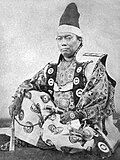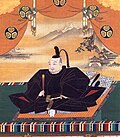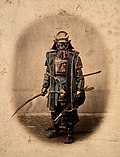Daimyo (大名, daimyō, Japanese pronunciation: [daimʲoː] ) were powerful Japanese magnates, feudal lords who, from the 10th century to the early Meiji period...
12 KB (1,300 words) - 08:33, 22 November 2024
the country, particularly smaller regions, daimyō, and samurai were more or less identical, since daimyō might be trained as samurai, and samurai might...
53 KB (5,110 words) - 02:52, 24 February 2025
Tozama daimyō (外様大名, "outside daimyō") was a class of powerful magnates or daimyō (大名) considered to be outsiders by the ruler of Japan during the Edo...
6 KB (709 words) - 01:10, 22 December 2024
Fudai daimyō (譜代大名) was a class of daimyō (大名) in the Tokugawa Shogunate (徳川幕府) of Japan who were hereditary vassals of the Tokugawa before the Battle...
11 KB (1,362 words) - 04:25, 13 November 2024
island of Dejima in Nagasaki, beginning a period of isolation. From 1635, daimyō had to spend alternating years in the capital Edo, where their family was...
91 KB (11,182 words) - 23:50, 11 February 2025
Domain. Non-daimyō relatives, such as the Gosankyō, were also known as kamon – thus the shinpan lords were alternatively known as kamon daimyō (家門大名). Shinpan...
2 KB (200 words) - 13:04, 2 May 2024
became daimyō of the Chōshū Domain under the Tokugawa shogunate. After the Meiji Restoration with the abolition of the han system and daimyō, the Mōri...
12 KB (1,353 words) - 16:10, 3 February 2025
fudai daimyō, while those who pledged allegiance to him after the battle (after his power was unquestioned) were known as tozama daimyō. Tozama daimyō were...
243 KB (27,237 words) - 23:19, 24 February 2025
Oda Nobunaga (category Daimyo)
clan and launched a war against other daimyō to unify Japan in the 1560s. Nobunaga emerged as the most powerful daimyō, overthrowing the nominally ruling...
171 KB (21,136 words) - 19:54, 24 February 2025
Ashikaga shogunate, the de facto central government, declined and the sengoku daimyo (戦国大名, feudal lord of Sengoku period), a local power, seized wider political...
55 KB (5,642 words) - 22:23, 23 February 2025
Tosa Domain (section List of daimyō)
and peasants fleeing to other territories. The ninth daimyō, Yamauchi Toyochika and the 13th daimyō, Yamauchi Toyoteru attempted reforms based on fiscal...
22 KB (1,530 words) - 16:13, 15 January 2025
Aizu Domain (section List of daimyō)
the shinpan daimyō of the Aizu-Matsudaira clan, a local cadet branch of the ruling Tokugawa clan, but was briefly ruled by the tozama daimyō of the Gamō...
21 KB (1,744 words) - 17:04, 26 January 2025
A daimyō collection is a collection mostly of the property or former property of daimyō, or feudal aristocrat families of Japan, which are now open to...
3 KB (336 words) - 06:38, 6 January 2025
Japan from 1603 to 1868 during the Edo period. It was formerly a powerful daimyō family. They nominally descended from Emperor Seiwa (850–880) and were a...
21 KB (2,263 words) - 01:26, 12 February 2025
were all daimyō chosen due to their relation to the taikō and the amount of power they held in the country. Hideyoshi chose powerful daimyō to prevent...
32 KB (4,311 words) - 17:41, 5 February 2025
Shimazu Tadayoshi (2nd) (category Tozama daimyo)
December 26, 1897) was a Japanese daimyō of the late Edo period, who ruled the Satsuma Domain as its 12th and last daimyō until 1871. He succeeded his father...
3 KB (101 words) - 08:23, 9 January 2025
rulers, later called daimyōs. In time, a balance of power evolved between the shōgun and the daimyōs; the three most prominent daimyō families rotated as...
23 KB (2,921 words) - 01:18, 9 February 2025
Edo society (section Daimyō)
the court ranks were used to control the daimyo. The daimyō were samurai feudal lords. The daimyō were high-ranking members of the samurai, and, similar...
24 KB (2,885 words) - 10:59, 10 May 2024
controls on the daimyōs, and the alternate attendance system, which required each daimyō to spend every other year in Edo. Even so, the daimyōs continued to...
138 KB (16,366 words) - 15:25, 24 February 2025
1723–1793), Japanese daimyō Inaba Masakatsu (稲葉 正勝, 1597–1634), Japanese daimyō Inaba Masakuni (稲葉 正邦, 1834–1898), Japanese daimyō Inaba Masami (稲葉 正巳...
3 KB (423 words) - 13:09, 19 December 2019
1868, the starting year of the Meiji period. Under the reform, all daimyos (大名, daimyō, feudal lords) were required to return their authority to the Emperor...
6 KB (793 words) - 21:28, 29 June 2024
This is a list of daimyōs from the Sengoku period of Japan. Nanbu Nobunao Nanbu Toshinao Tsugaru Tamenobu Date Harumune Date Terumune Date Masamune Date...
23 KB (1,202 words) - 09:42, 18 September 2024
the majority of daimyō armies, so they accounted for the majority of ronin.[citation needed] Especially in the Sengoku period, daimyō needed additional...
16 KB (1,966 words) - 19:11, 22 January 2025
capital of Heian-kyō (Kyoto) as de facto military dictators along with the daimyō lords of the samurai class. The Ashikaga shogunate began the Nanboku-chō...
15 KB (1,526 words) - 11:17, 10 January 2025
generation daimyō of Tsu Domain in Ise Province. Matsudaira Ienori – daimyō of Iwamura Domain in Mino Province. Matsudaira Norinaga – daimyō of Iwamura...
14 KB (1,487 words) - 15:20, 20 October 2023
Kaga Domain (section List of daimyōs)
1st daimyō of Kaga (cr. 1583) (1539–1599; r. 1583–1599) II. Toshinaga, 2nd daimyō of Kaga (1562–1614; r. 1599–1605) III. Toshitsune, 3rd daimyō of Kaga...
15 KB (965 words) - 15:42, 24 September 2024
Imagawa Yoshimoto (category Daimyo)
1560) was a Japanese daimyō (feudal lord) of the Sengoku period. Based in Suruga Province, he was known as The number one Daimyō in the Tōkaidō (海道一の弓取り...
11 KB (1,122 words) - 08:40, 11 July 2024
ended a dynasty of daimyōs. When the Hōjō clan were defeated at Odawara in 1590, Hideyoshi insisted on the suicide of the retired daimyō Hōjō Ujimasa and...
46 KB (5,581 words) - 00:56, 2 February 2025
held leadership positions in their villages, and became vassals of sengoku daimyō (戦国大名). Their status was half farmer, half bushi (samurai). On the other...
126 KB (15,097 words) - 19:12, 18 February 2025
Shimabara Domain (section List of daimyōs)
Masanao, 2nd daimyō of Tsuchiura (1641–1722) Tsuchiya Nobunao, 3rd daimyō of Tsuchiura (1696–1734) daughter, m. IV. Matsudaira Tadatoki, 4th daimyō of Shimabara...
23 KB (1,741 words) - 22:47, 20 December 2024






















